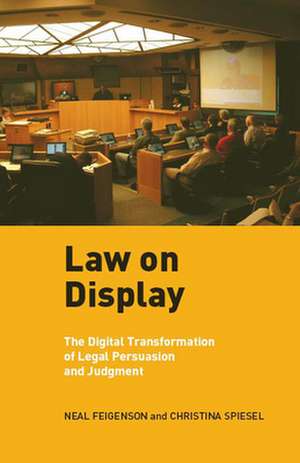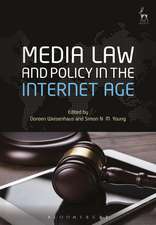Law on Display – The Digital Transformation of Legal Persuasion and Judgment: Ex Machina: Law, Technology, and Society
Autor Neal Feigenson, Christina Spieselen Limba Engleză Paperback – 12 mai 2011
In this comprehensive survey and analysis of how new visual technologies are transforming both the practice and culture of American law, Neal Feigenson and Christina Spiesel explain how, when, and why legal practice moved from a largely words-only environment to one more dependent on and driven by images, and how rapidly developing technologies have further accelerated this change. They discuss older visual technologies, such as videotape evidence, and then current and future uses of visual and multimedia digital technologies, including trial presentation software and interactive multimedia. They also describe how law itself is going online, in the form of virtual courts, cyberjuries, and more, and explore the implications of law s movement to computer screens. Throughout Law on Display, the authors illustrate their analysis with examples from a wide range of actual trials."
| Toate formatele și edițiile | Preț | Express |
|---|---|---|
| Paperback (1) | 229.94 lei 43-57 zile | |
| MI – New York University – 12 mai 2011 | 229.94 lei 43-57 zile | |
| Hardback (1) | 529.69 lei 43-57 zile | |
| MI – New York University – 30 sep 2009 | 529.69 lei 43-57 zile |
Preț: 229.94 lei
Nou
Puncte Express: 345
Preț estimativ în valută:
43.100€ • 46.05$ • 36.62£
43.100€ • 46.05$ • 36.62£
Carte tipărită la comandă
Livrare economică 31 martie-14 aprilie
Preluare comenzi: 021 569.72.76
Specificații
ISBN-13: 9780814728451
ISBN-10: 0814728456
Pagini: 350
Ilustrații: black & white illustrations, figures
Dimensiuni: 152 x 229 x 15 mm
Greutate: 0.46 kg
Editura: MI – New York University
Seria Ex Machina: Law, Technology, and Society
ISBN-10: 0814728456
Pagini: 350
Ilustrații: black & white illustrations, figures
Dimensiuni: 152 x 229 x 15 mm
Greutate: 0.46 kg
Editura: MI – New York University
Seria Ex Machina: Law, Technology, and Society
Recenzii
"This is a widely informed, wisely reasoned, accessible analysis of how, for good or for evil, digital visual technology is transforming the conduct of trials and the very meaning of truth in the courtroom. It is essential reading alike for litigators and for everyone concerned with the legal fall-out of our culture's accelerating shift from verbal to multimedia communication and comprehension." Anthony G. Amsterdam, New York University School of Law"Feigenson and Spiesel combine their impressive talents in law and visual persuasion to provide us with an insightful account of how new media are transforming legal advocacy in powerful new directions. Their critical analyses of fascinating case studies illustrate how cutting-edge lawyers are employing visual and digital media. The authors alert us to the new medias transformative capacity yet also its manipulative potential, and cogently discuss the ethical and legal quandaries that new media present for the courts. Highly recommended." Valerie P. Hans, co-author of American Juries: The Verdict"Feigenson and Spiesel persuasively argue for a more critical and contextualizing approach to the growing flood of digital imagery in the courtroom. Given the enormous power of imagery to sway opinions and the innovative ways in which visuals can now be presented, judges, jurors, and especially lawyers are obligated to know how to interrogate these new forms of evidence and explication. Law on Display serves as a timely and comprehensive introduction to digital visual literacy in the legal system." Fred Ritchin, author of After Photography
Notă biografică
Descriere
Explains how, when, and why legal practice moved from a largely words-only environment to one more dependent on and driven by images and how rapidly developing technologies have further accelerated this change















